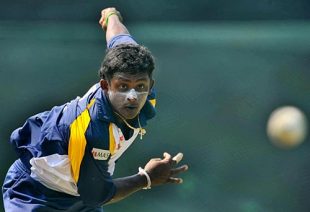|
|
|

His army traning gave Mendis discipline, a stronger middle finger, and a stock ball
© AFP
|
|
| |
"Not naughty but a clever child," says Ajantha Mendis' mother, Ranjani. We are in the large living room of a lovely duplex house in a nice neighborhood in Moratuwa, near Colombo. Mendis is expected in 10 minutes.
I showed up uninvited. Two stuffed tigers lie on the floor, a showcase brims with trophies, two decorative rocket shells stand adjacent to the large sofa, and a staircase winds up at the far end of the room.
"We wanted to move to a town," Ranjani says. They moved into this new house in August 2008 after Mendis was promoted to second lieutenant in the army. Before that they lived in a little village outside Moratuwa, where Mendis' father, Wenses, plied his trade as a carpenter and Ranjani worked as a supervisor at an apparel factory.
Wenses was a village cricketer who sensed that his son could be really good at the game. Mendis used to play tennis-ball cricket with his brother Aruna, who could pick his variations "sometimes". Mendis was the superior cricketer not only in the family but also in neighbourhood street cricket. Wenses saved up religiously to send the boy to a coaching camp, run by Lucky Rogers, himself a very talented school and first-class cricketer in his day.
It was there that the boy got his first glimpse, an insight, into his own strengths and potential. He returned home knowing his destiny. "We knew when he was 13 that he can become a very good cricketer," Ranjani says. The son, never too keen on academics, relaxed, having found his path - to become a cricketer like Muttiah Muralitharan.
Rogers got Mendis to move from Kadalana St Anthony's Vidhyalaya to the more cricket-friendly Moratu Maha Vidhyalya. Mendis repaid the trust, bagging the Best Bowler prize in 2002 and 2003 in the traditional big game against Sri Sumangala College, Panadura.
A way that would enable him to earn a living while following his dream had to be found. It came in the form of the army. The Sri Lankan Army Cricket Committee, impressed by Mendis' talent, invited him to join a regiment. Wenses approved, realising the army would enable his son to be employed and continue to play cricket. However, he passed away two weeks before his 19-year-old son joined the army, in 2003. "Every time I play, it's a tribute to my father," Mendis said in an interview. The loss made him doubly determined to become a cricketer.
The army training was "impossibly challenging" and helped Mendis become disciplined, which influenced his game as well. Till then he had been a boy who experimented with various deliveries, "trying to get a wicket every ball". Two coaches, Saman Hewawitharana and Saman Galappathi, helped him mature enough to realise he had to develop a method if he was to overcome different batting styles. Under the urging of the captain and the senior players, Mendis accepted the wisdom of developing a stock ball. The offbreak was chosen for the task.
The army allowed him to experiment. He had just the carrom ball and the offbreak when he joined, but he soon expanded his repertoire, honing his variations to perfection. He developed the topspinner and the flipper at a spin clinic run by Ashley Mallett, the former Australian spinner, and under the eyes of the head coach, Ruwan Kalpage.
The local press speculated that the job as a gunner helped strengthen Mendis' now-famous middle finger. His brother Aruna doesn't think so. "He always had strong fingers." The gunner exercises may have ensured they remained strong.
| |
|
|
|
| |
| Interestingly, not one of his coaches tried to alter his style. He was lucky, of course, but it might also be because his style was so original and effective that no one dared change it, or that they thought an altered style might nullify his potency |
| |
|
|
|
|
Interestingly, not one of his coaches tried to alter his style. He was lucky, of course, but it might also be because his style was so original and effective that no one dared change it, or that they thought an altered style might nullify his potency. I tried meeting his army coaches to nail down the exact thought, but given the conflict in Sri Lanka it was impossible; I was told the clearance wouldn't come.
For his part, Mendis came out of the army with a lot of respect for the soldiers. He remains loyal and tries to play as many games as possible for them.
In his first major game, in an Under-23 tournament in July 2006, he ended up with figures of 3.4-1-5-3 in the first innings. On his List A debut he picked up 2 for 38. In his debut first-class game, though, he went wicketless from 24 overs in the match. However, he grabbed a five-for in the next game and went on to claim 43 wickets in the season. The next season he hauled in 68 wickets at the sensational average of 10.51. Still, as you would expect, he was incredibly nervous when he made his international debut in April 2008, against West Indies. It was Mahela Jayawardene and Kumar Sangakkara who made him feel that he belonged and put him at ease in the team environment. The rest we know.
Faith and family
A dog growls from upstairs. Mendis has arrived. He parks his SUV and rushes into the house. He is surprised he has visitors. "Sorry, but I can't talk, machang. Busy. Going out now." His mother explains that he is going to a church at Ragarama, outside Colombo. "He seeks blessings there before a big event." Mendis is to soon embark on a tour of Pakistan to play Tests. Does she want to accompany him on any foreign tours? She smiles before saying that there are no plans as of now. There will be enough opportunities in the future.
Mendis' elder sister, Aruni, wants to come to India during the IPL, but fears her exams might kill her dream. "I really like Dhoni." She shows a picture of herself with Dhoni, taken during India's last tour. There's also a picture of Mendis with Shahrukh Khan. "I like Hindi film songs. Ajantha watches now and then." He prefers humming old Sinhala songs and playing pool with his friends.
Aruni has lovingly scribbled her brother's bowling figures on the balls that bewildered the Indian batsmen last year. They adorn the trophy cabinet. Several shields lie on the floor. Mother and daughter bring out old family albums. "That was when he was six months. That was his first birthday. This is when he came back from the Asia Cup." It was Ranjani's proudest moment: when Mendis was welcomed by his village in a motorcade that was thronged by loving admirers.
Nostalgia is never boring. But what about the future? What does she want from her son? "Nothing. He is only 23 years old and I just want him to do well for the country in cricket."
It's another Mendis trait that Ajantha has benefited from. Ranjani has only ever sought to help her children shape their futures according to their wishes; she has never interfered. She sees it as ordained by God. The third son, Asanka, younger than Ajantha, is studying to become a priest. A mystery bowler and a man seeking to understand the mysteries of life. "Whatever god wants." The sentiment is, of course, tempered with maternal feeling, and a sense of what her husband wanted. The only promise that she extracted was from the army: that her son shouldn't be sent to the front to fight. "His father wanted him to play cricket."
The son has mesmerised the world by playing cricket. His middle finger was among the most popular images in cricket last year, as Youtube rankings prove. During the series against India he helped increase the sex appeal of Test cricket. If Murali won't, Mendis will, went the chant. M&M entered the cricket jargon. Across school grounds, little boys propelled tennis balls using their middle fingers.
Cracking the code
Mendis knows his strength and plays to the gallery. He announced recently that he is working on a "different" ball. "This is different from the carrom ball. I was testing this ball in the nets during net sessions earlier, but I might use it during match time." One of the early practitioners of the mystery spinner's art, John Gleeson,
spoke about the phenomenon recently: "I was told I had six different balls. That was bullshit. You've only got three as far as I'm concerned: one goes straight, one spins from the leg and the other one spins from the off. You can't do anything else."
|
|
|

Mendis' sister and mother (from left), outside the family home
© Cricinfo Ltd
|
|
| |
The art lies in deception. In trying to get the batsman thinking that it's turning in when it's going out. That's the initial stage. Later, spinners play on their reputation: let the batsman think this might be going out because it looks like it's going to turn in. When batsmen eventually get confident about the ball's destination, these mystery bowlers will have to evolve. The batsman might then know where it's going, but can he still play it?
There has been talk in recent times that Mendis has been sorted out by the Pakistanis and the Indians. Salman Butt found that his natural tendency to play beside the line was a weapon against Mendis. He prospered by honing that style.
Play him as a medium-pacer, went the cry. Don't get your front leg across, and never play across the line, were branches of that thought. It has worked in limited-overs cricket, where the bowler has only 10 overs and not too many sustained spells within that to deploy his mystery. Mendis will have to re-adjust. Evolve.
Whether the recent results have affected his potency in Test cricket, where the M&M firm is doubly dangerous with their sustained pressure, remains to be seen, though. Moreover there is the matter of that ankle injury. Murmurs about an expanding waistline have been doing the rounds as well.
Arjuna Ranatunga, that wily old captain, does not think that even in ODI cricket Mendis' mystery has been laid bare. He sees it as just a temporary blip, which he blames on the briefness of the recuperation period after the injury. "The ankle injury hasn't completely healed. Look at the videos of the two series. He is not landing his feet properly this time. He is not transferring the weight on the front foot as he would have liked. All I would like to say at this point is, let's just wait for some time till he regains his full fitness before passing any verdict. The boy will bounce back."
Ranjani hopes her son will play long and do really well. That's what his father wanted. "Nothing is impossible," Mendis said, addressing the country's youth in the February issue of a local magazine. "Just try to be different and you will achieve what you want." He should know.
Sriram Veera is a staff writer at Cricinfo

